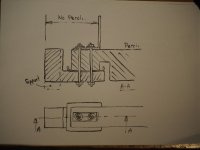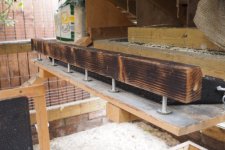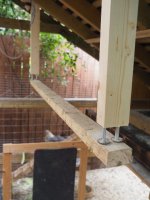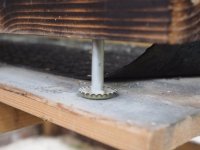You are using an out of date browser. It may not display this or other websites correctly.
You should upgrade or use an alternative browser.
You should upgrade or use an alternative browser.
Anti-mite perches
- Thread starter rick
- Start date
That looks brilliant, so long as you have perches supported in the way yours are. Mine, like many others, plug sideways into the wall of the coop. Any ideas for that type?
rick
Active member
I couldn't think of a way to compact it in height to 2 x 3 inch Marigold, at least not easily. Painting diatom slurry in the sockets before sliding the perch in is probably the best option unless you have enough head height for the hens too raise the perch on the posts (obviously so the suspended perch doesn't touch the sides.
If there are any injection moulders out there I can imagine perch ends that go onto a standard bar and into the perch sockets (if perch sockets/perches were a standard fit.)
I did make this temporary free standing perch for the CLBs. The temporary perch is on the other side of the run where I had never seen any red mite until the main perches became a no go option. It took them about a week to appear on the other side to nibble the pullets which was interesting. Again, the problem is that the idea raises the perch higher than some coops can stand maybe.

Just for the record - I think you could do it like below but it uses up perch length as the hens have to stay away from the join and the wall. I'll give it a rest now!

If there are any injection moulders out there I can imagine perch ends that go onto a standard bar and into the perch sockets (if perch sockets/perches were a standard fit.)
I did make this temporary free standing perch for the CLBs. The temporary perch is on the other side of the run where I had never seen any red mite until the main perches became a no go option. It took them about a week to appear on the other side to nibble the pullets which was interesting. Again, the problem is that the idea raises the perch higher than some coops can stand maybe.

Just for the record - I think you could do it like below but it uses up perch length as the hens have to stay away from the join and the wall. I'll give it a rest now!

bigyetiman
Well-known member
- Joined
- May 16, 2017
- Messages
- 2,474
- Reaction score
- 249
I hope it works for you, a simple cheap solution. Keep on inventing
rick
Active member
Well I'll let you all know in 12 months time - if I knobble the anti-mite system for 2 - 3 weeks and they appear again.
Thanks Dinosaw and Bigyetiman - its a habit that's unlikely to change after all these years - get an idea and just have to build it!
Quite confident that the mites can no longer get to a hen on a perch now in the night when they do their main munching but
not sure about nest boxes. Do you think, if the boxes are not in the dark (just a bit of a half curtain), that they wouldn't try to have a bite in the daytime? I don't think they do as I first got worried about having mite around when Aerial was refusing to perch in favour of the nest boxes. Never seen any mite in there but, when they have to, they will trek quite a distance from an un-found crevice. But the idea that they might 'see' a hen enter a nest box then set out on a raid from a distance seems unlikely - not a sustainable way to multiply anyway.
Its a funny time of year to know anything for sure. Even Bonnie is now off lay (getting feathered up and Orp beautiful again though) - Aerial hasn't laid an egg in 2 months and that was a one off! Anyone else got a blacktail that just seems to have decided that laying eggs is for losers at 2 1/2 years of age?
Thanks Dinosaw and Bigyetiman - its a habit that's unlikely to change after all these years - get an idea and just have to build it!
Quite confident that the mites can no longer get to a hen on a perch now in the night when they do their main munching but
not sure about nest boxes. Do you think, if the boxes are not in the dark (just a bit of a half curtain), that they wouldn't try to have a bite in the daytime? I don't think they do as I first got worried about having mite around when Aerial was refusing to perch in favour of the nest boxes. Never seen any mite in there but, when they have to, they will trek quite a distance from an un-found crevice. But the idea that they might 'see' a hen enter a nest box then set out on a raid from a distance seems unlikely - not a sustainable way to multiply anyway.
Its a funny time of year to know anything for sure. Even Bonnie is now off lay (getting feathered up and Orp beautiful again though) - Aerial hasn't laid an egg in 2 months and that was a one off! Anyone else got a blacktail that just seems to have decided that laying eggs is for losers at 2 1/2 years of age?
RichmondHens
New member
Mites don't just crawl along perches, they will also live higher up near the roof then just drop off onto the hens at night. So just making perches "mite proof" isn't going to stop them, although I admire your efforts.
At the risk of losing birds to foxes, my radical solution to reducing red mite population this year was to not shut the hens up at all. Therefore during the longest days the birds were out of the houses by 4 am and not in again until at least 10 pm. Not only did I find almost no mite in the houses (two small colonies in two of the houses was the grand total and they were dealt with using creosote), egg production also increased, even amongst the older birds.
At the risk of losing birds to foxes, my radical solution to reducing red mite population this year was to not shut the hens up at all. Therefore during the longest days the birds were out of the houses by 4 am and not in again until at least 10 pm. Not only did I find almost no mite in the houses (two small colonies in two of the houses was the grand total and they were dealt with using creosote), egg production also increased, even amongst the older birds.
Yes I agree about not shutting them up in the coop at night, I never do that, winter or summer. There are so many advantages, mainly to the hens but also to the keeper - full ventilation and better air quality in the coop, no condensation from damp feathers in a closed coop overnight, hence less risk of bronchitis etc; no need to keep going round after dark, in all weathers, or to get up early enough to release the restless girls in summer. And if you have to go away, it's much easier to get someone else to pay one daily visit, to check, feed, water, clean up and collect eggs, than for them to have keep running around morning and night as well. Of course, you have to keep the flock in conditions which are safe from predators, but since foxes often strike during the day or before the hens go to roost, I think this should be a consideration anyway. Maybe my long-term freedom from mites in the coop is due to this method of management, if you've also noticed a big reduction in mites this summer, RH.
RichmondHens
New member
I'm sure you're right Marigold. Reducing availability of the mites' food source ie blood must have an impact on their breeding. I'm still not shutting the birds up and at the moment am thinking I'll leave the popholes open all winter unless the weather turns really nasty. We live on top of a hill and it's always fairly breezy up here so should we get driving sleet/snow/rain then I may close them for the night but otherwise am inclined to leave them be. Of course a fox attack may change my mind, but fortunately the foxes are very wary around here, and heavily controlled by the gamekeeper.
rick
Active member
And you are right Richmondhens - it took a lot of finding and I am surprised but:
http://nrl.northumbria.ac.uk/4506/1/S0043933909000403a.pdf
page 592, "As Maurer (1993) found during her experiments, PRM can drop from the ceiling,.."
Walking would be more reliable - in a smaller space though (like most coops) yes!
http://nrl.northumbria.ac.uk/4506/1/S0043933909000403a.pdf
page 592, "As Maurer (1993) found during her experiments, PRM can drop from the ceiling,.."
Walking would be more reliable - in a smaller space though (like most coops) yes!
chrismahon
Well-known member
Seen it Rick. If they can't get to the hens via the perches they will crawl up the roof and drop on them. They can't jump up though- small relief. So unfortunately your perches only trap them on the birds, because they can just drop down off the perch onto the floor and crawl up the walls the next night.
rick
Active member
Well Chris - I have to say that must be pretty desperate behaviour on their part and much preferred would be to follow a regular pheromone path (like ants) from a favourite hiding place, along surfaces to the host and safely back again by morning. With just one or two staying on board to hitch a lift to the next branch in the wild.
As a moderate infestation is apparently 50,000 per bird then there will be a regular mite cascade going on every night from the ceiling. Personally I'm reading it as - if they prospectively follow the heat direction of a hen up a wall and across the ceiling (in a small box they may well do that) and reach a position where the only way to get closer is by dropping then they will.
It would be a precarious way of living in our run but I have to agree, and its unfortunate, that in a small coop or a commercial layers enhanced cage its too easy for them to get anywhere they want without expending a great deal of effort and do it all again two nights later.
Anyway - sorry for hotly contesting this - I do know my mites are getting pretty sharp for a plan B at the moment and its good to know what it might be . Its getting cooler now anyway which is a mixed blessing.
P.S. I've been a real pain in the ass with this thread and its only because I now realise (or have fairly recently) that we have had red mite all summer. When I took the roosting perches and shelf apart to rebuild I found old mite haunts that were obvious as such because they had white deposits of dead generations of exoskeletons amongst the brood. During this time the nearer hot spots that were obvious were rarely inhabited with diligent observation and clearing - for, on average, three weeks between spotting and wiping out. But they have been around all this summer and last (probably have been since first appearing about 3 years ago though that was the first time I knew what, an how, to look for them.)
I think, no evidence other than a hunch, that their presence has been related to raised calcium patches on the eggs because this feature disappeared recently though that was just before both Aerial and Bonnie stopped laying for the autumn. (who knows)
If I had a traditional set up (which being an oddball I don't!) then being able to strip down as much of it as possible is always going to be a good idea. And here I'll hazard an opinion - Mites are pretty natural anywhere there are birds. Problem is when we keep hens in one place - a wild bird would quickly shun a mite ridden perch (next night at least) and they would be in small numbers under tree bark waiting for the next meal. (unless the wildfowl population was out of control.)
As I said at the start of this thread, there are lots of ways of doing it. Don't worry if you get them (some dont) just keep a watchful eye and keep them screwed down to a wild population by whatever means possible. If we can keep them to wild population levels in the coop it really shouldn't bother the hens. It so easily gets out of hand though. The crafty little #@**###!
As a moderate infestation is apparently 50,000 per bird then there will be a regular mite cascade going on every night from the ceiling. Personally I'm reading it as - if they prospectively follow the heat direction of a hen up a wall and across the ceiling (in a small box they may well do that) and reach a position where the only way to get closer is by dropping then they will.
It would be a precarious way of living in our run but I have to agree, and its unfortunate, that in a small coop or a commercial layers enhanced cage its too easy for them to get anywhere they want without expending a great deal of effort and do it all again two nights later.
Anyway - sorry for hotly contesting this - I do know my mites are getting pretty sharp for a plan B at the moment and its good to know what it might be . Its getting cooler now anyway which is a mixed blessing.
P.S. I've been a real pain in the ass with this thread and its only because I now realise (or have fairly recently) that we have had red mite all summer. When I took the roosting perches and shelf apart to rebuild I found old mite haunts that were obvious as such because they had white deposits of dead generations of exoskeletons amongst the brood. During this time the nearer hot spots that were obvious were rarely inhabited with diligent observation and clearing - for, on average, three weeks between spotting and wiping out. But they have been around all this summer and last (probably have been since first appearing about 3 years ago though that was the first time I knew what, an how, to look for them.)
I think, no evidence other than a hunch, that their presence has been related to raised calcium patches on the eggs because this feature disappeared recently though that was just before both Aerial and Bonnie stopped laying for the autumn. (who knows)
If I had a traditional set up (which being an oddball I don't!) then being able to strip down as much of it as possible is always going to be a good idea. And here I'll hazard an opinion - Mites are pretty natural anywhere there are birds. Problem is when we keep hens in one place - a wild bird would quickly shun a mite ridden perch (next night at least) and they would be in small numbers under tree bark waiting for the next meal. (unless the wildfowl population was out of control.)
As I said at the start of this thread, there are lots of ways of doing it. Don't worry if you get them (some dont) just keep a watchful eye and keep them screwed down to a wild population by whatever means possible. If we can keep them to wild population levels in the coop it really shouldn't bother the hens. It so easily gets out of hand though. The crafty little #@**###!
chrismahon
Well-known member
I read somewhere that red mite detect body heat and aim for it. However, after constructing a heat mat and covering it with fly paper and catching absolutely nothing, I have to conclude there is more to it than just heat. I tried covering the papers with feathers but that didn't work either, so pheromones must be the answer as you say Rick.
We wipe out red mite by steam cleaning the coop first. Then, to get the mite off the birds and kill them (because lots don't get off) we treat the perch ends with creosote. This traps most of the mite on the perches and every morning the perch is removed, all the mite are killed and it is replaced. Takes about two weeks of that process to wipe them out completely. Sometimes a second steam clean is required and the perch process repeated. Red mite also live outside in soil baths so we add a small amount of potash which seems to work. Worst case was with the Orpingtons when the perch trapped an estimated 13,500 (based on random counts in 1 cm2.
We wipe out red mite by steam cleaning the coop first. Then, to get the mite off the birds and kill them (because lots don't get off) we treat the perch ends with creosote. This traps most of the mite on the perches and every morning the perch is removed, all the mite are killed and it is replaced. Takes about two weeks of that process to wipe them out completely. Sometimes a second steam clean is required and the perch process repeated. Red mite also live outside in soil baths so we add a small amount of potash which seems to work. Worst case was with the Orpingtons when the perch trapped an estimated 13,500 (based on random counts in 1 cm2.
rick
Active member
That was a cool experiment Chris!
This has only just occurred to me properly from your prompt although I think I had a niggling suspicion -
Lots of insects operate this way - a bit like discovering the Americas. A scout mite checks out the heat source (along with other sensory leads) and if it strikes gold it leaves a pheromone trail on the way back to base (if it gets back to base.) More mite follow the trail and the trail turns into a motorway over a several nights.
--- like ants - not like Columbus at all really - mites don't return with potatoes 07 ...
07 ...
This has only just occurred to me properly from your prompt although I think I had a niggling suspicion -
Lots of insects operate this way - a bit like discovering the Americas. A scout mite checks out the heat source (along with other sensory leads) and if it strikes gold it leaves a pheromone trail on the way back to base (if it gets back to base.) More mite follow the trail and the trail turns into a motorway over a several nights.
--- like ants - not like Columbus at all really - mites don't return with potatoes



